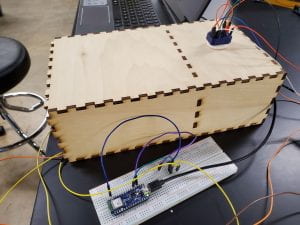I can’t believe another week has passed! Though a short week with the long weekend, week 4 has proven to be the week where Team PetriFI has made some of the largest breakthroughs in the internship thus far. While we are still trudging through debugging our breadboard, we have fortunately been able to meet with multiple mentors to work through the issues. In the meantime, we rigged together a circuit to begin testing the efficacy of our planned heating chamber.
Pictured below is the first iteration of the chamber: a box made of polyiso cut with an exacto knife and fashioned together/made air-leak proof with epoxy. The inside surfaces are covered in foil to aid in insulation and the heating pad simply rests on top of a bed of insulation so it’s not touching the foil (if it touches the foil, a lot of energy will be lost heating the foil before the air temperature increases significantly). We aptly called this low-fidelity prototype “Pink Box.” The most exciting part of this prototype for me though, was the tiny tiny tiny switch we used in the circuit to power on and off the heating pads. Upon some preliminary testing, we found this box to be quite robust in its incubation ability: even with a sizeable hole for the thermometer, it reached body temperature in under 8 minutes, at which point we switched off the heating pad, and then held that temperature (with the heating pads off) for 19 minutes. This was enough of a proof of concept for us to move forward with a more higher fidelity prototype.
For the next iteration of this prototype, we decided to laser cut a plywood chassis for the polyiso insulation attached to a chassis for the electronics and circuit. This time, we cut the polyiso with a saw more neatly and assembled it into the plywood box along with foil. Shown below is the setup:
We were lucky enough to be able to start testing this iteration with our knowledgeable client’s circuit system which automatically calculated the duty cycle (the percentage of time the heating pad needs to be on to hold body temperature over the course of a period of time). We found this iteration to have a duty cycle of under 10%. This is very exciting as it likely means our battery will be sufficient to incubate samples for 48 hours. To confirm this result, however, my teammates Kenton and Sara decided to run a variable voltage test where they hook the circuit up the a benchtop power supply and adjust the voltage until the chamber equilibrates to body temperature. The voltage at which this is reached can be used to create a ratio with the voltage of the battery we plan to use and then this data can be used to extrapolate how long our power source will last.
Next week, we will be meeting with our client and mentor, Dr. Read, to create a “code skeleton” to implement the user interface we designed. Because none of the team members have much experience coding Arduinos, I am not expecting to have a complete user interface coded by the end of the internship, but hopefully we will set up a framework for a new team to be able to quickly finish and iterate upon our design. To facilitate this, I also started a technical memo in the form of a journal article which will include all design files, code files, and assembly instructions along with motivations and justifications of the choices our team made.
Looking forward to another great week ahead!
Teja Paturu


